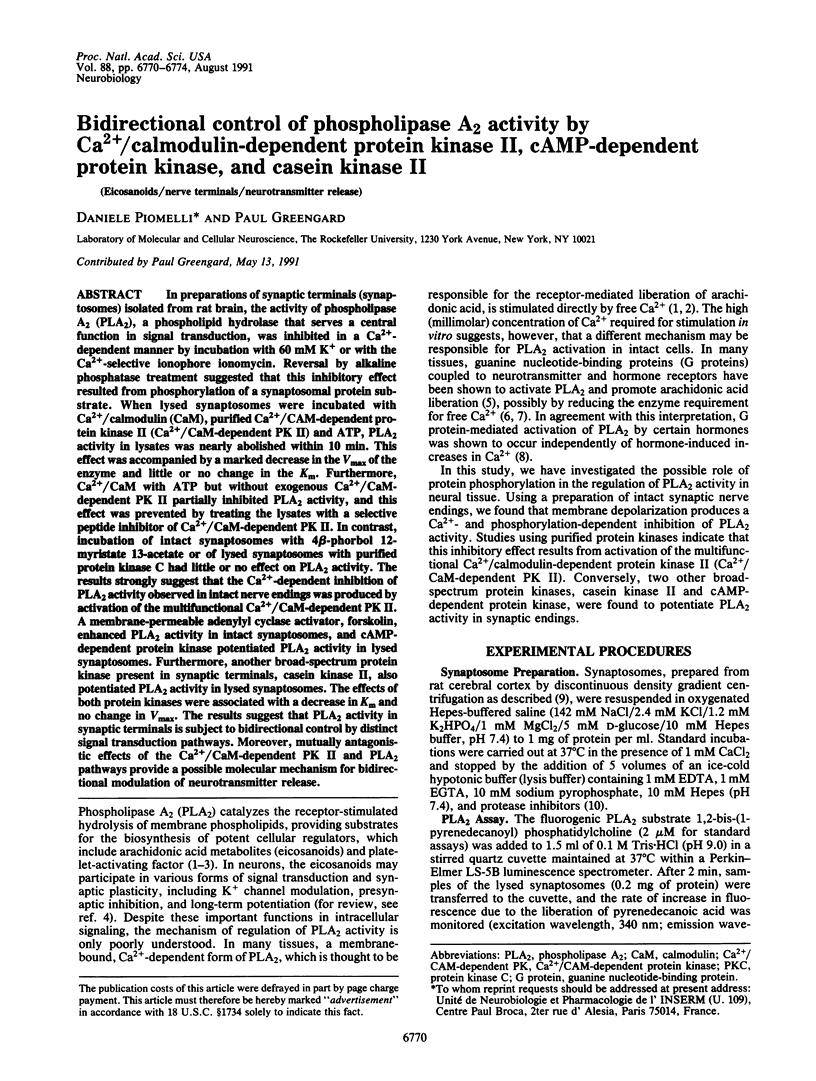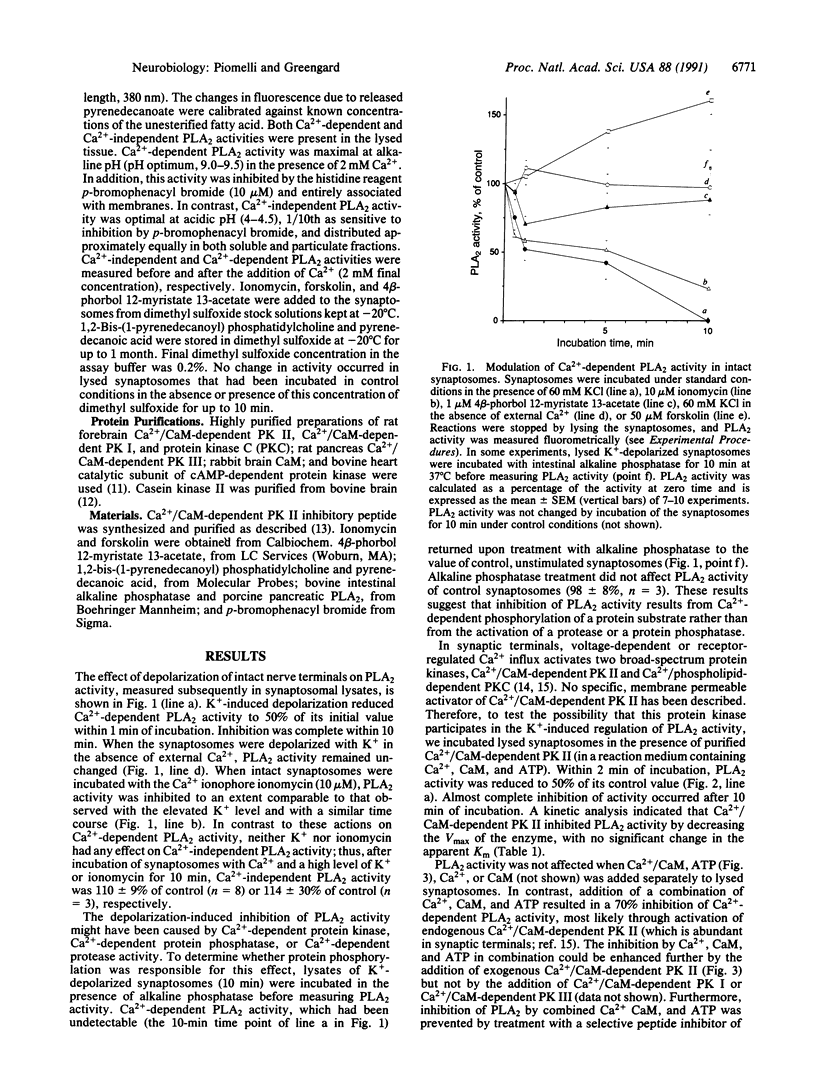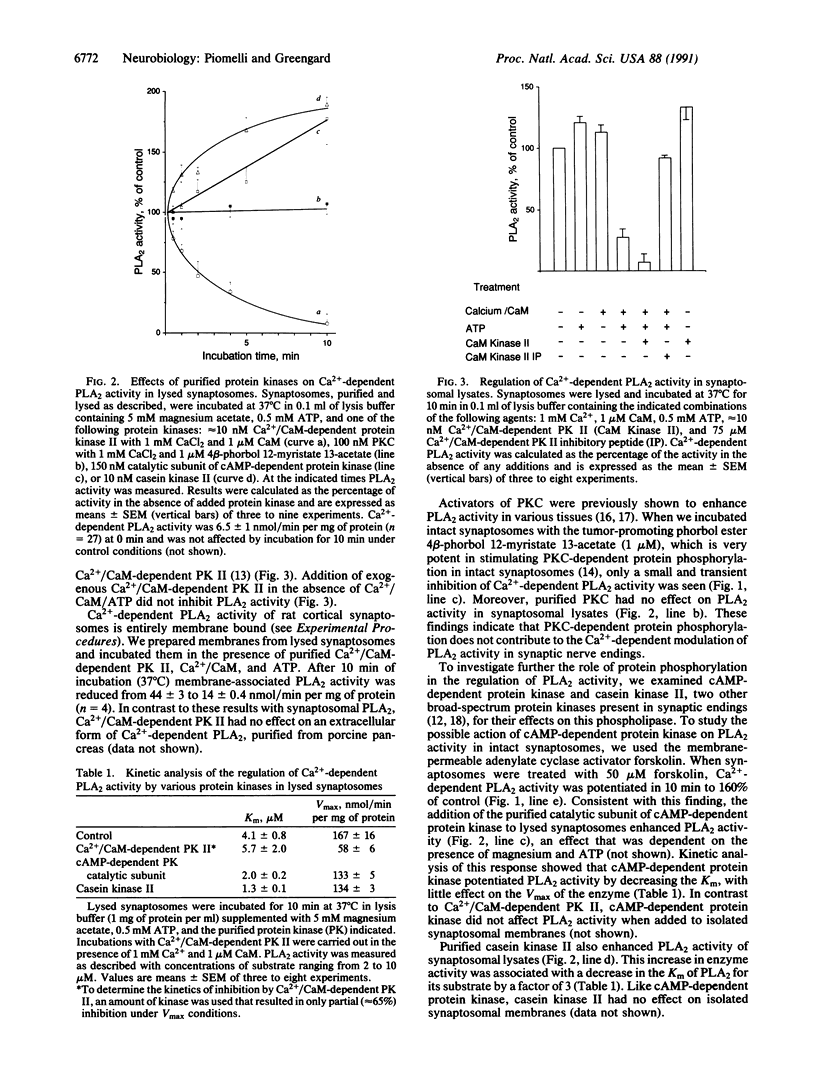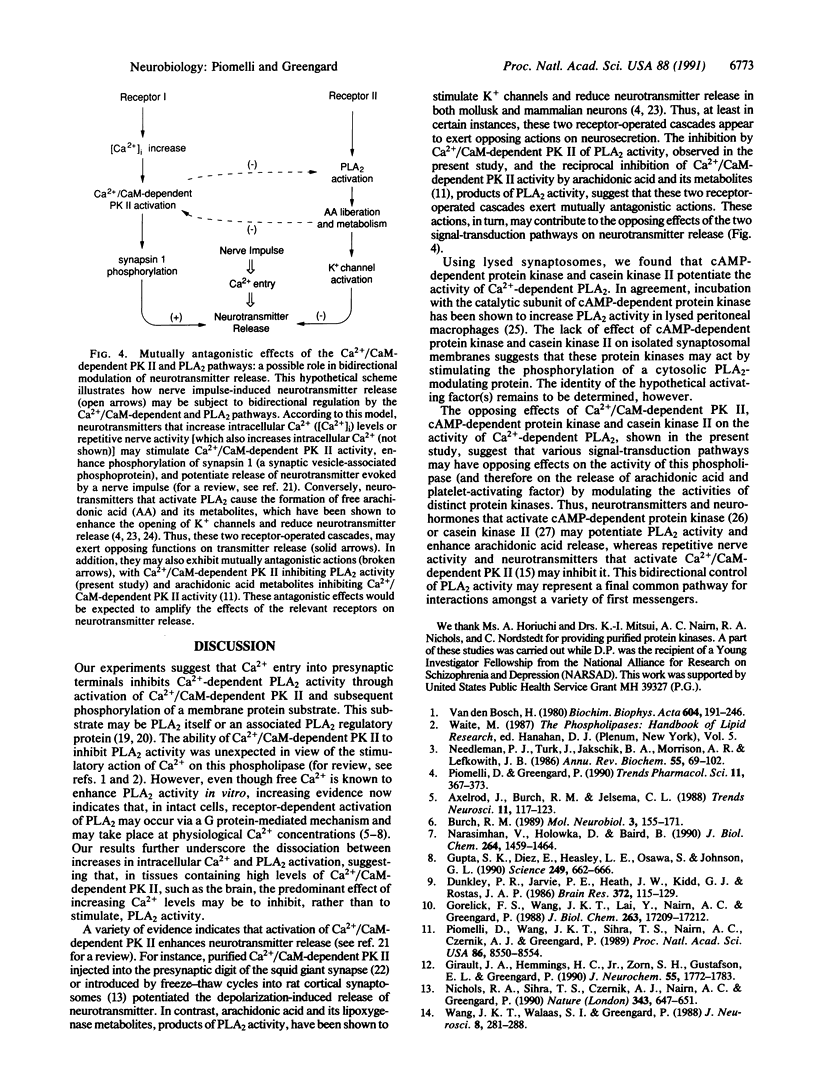Abstract
In preparations of synaptic terminals (synaptosomes) isolated from rat brain, the activity of phospholipase A2 (PLA2), a phospholipid hydrolase that serves a central function in signal transduction, was inhibited in a Ca(2+)-dependent manner by incubation with 60 mM K+ or with the Ca(2+)-selective ionophore ionomycin. Reversal by alkaline phosphatase treatment suggested that this inhibitory effect resulted from phosphorylation of a synaptosomal protein substrate. When lysed synaptosomes were incubated with Ca2+/calmodulin (CaM), purified Ca2+/CAM-dependent protein kinase II (Ca2+/CaM-dependent PK II) and ATP, PLA2 activity in lysates was nearly abolished within 10 min. This effect was accompanied by a marked decrease in the Vmax of the enzyme and little or no change in the Km. Furthermore, Ca2+/CaM with ATP but without exogenous Ca2+/CaM-dependent PK II partially inhibited PLA2 activity, and this effect was prevented by treating the lysates with a selective peptide inhibitor of Ca2+/CaM-dependent PK II. In contrast, incubation of intact synaptosomes with 4 beta-phorbol 12-myristate 13-acetate or of lysed synaptosomes with purified protein kinase C had little or no effect on PLA2 activity. The results strongly suggest that the Ca(2+)-dependent inhibition of PLA2 activity observed in intact nerve endings was produced by activation of the multifunctional Ca2+/CaM-dependent PK II. A membrane-permeable adenylyl cyclase activator, forskolin, enhanced PLA2 activity in intact synaptosomes, and cAMP-dependent protein kinase potentiated PLA2 activity in lysed synaptosomes. Furthermore, another broad-spectrum protein kinase present in synaptic terminals, casein kinase II, also potentiated PLA2 activity in lysed synaptosomes. The effects of both protein kinases were associated with a decrease in Km and no change in Vmax. The results suggest that PLA2 activity in synaptic terminals is subject to bidirectional control by distinct signal transduction pathways. Moreover, mutually antagonistic effects of the Ca2+/CaM-dependent PK II and PLA2 pathways provide a possible molecular mechanism for bidirectional modulation of neurotransmitter release.
Full text
PDF




Selected References
These references are in PubMed. This may not be the complete list of references from this article.
- Axelrod J., Burch R. M., Jelsema C. L. Receptor-mediated activation of phospholipase A2 via GTP-binding proteins: arachidonic acid and its metabolites as second messengers. Trends Neurosci. 1988 Mar;11(3):117–123. doi: 10.1016/0166-2236(88)90157-9. [DOI] [PubMed] [Google Scholar]
- Burch R. M. G protein regulation of phospholipase A2. Mol Neurobiol. 1989 Fall;3(3):155–171. doi: 10.1007/BF02935629. [DOI] [PubMed] [Google Scholar]
- Clark M. A., Conway T. M., Shorr R. G., Crooke S. T. Identification and isolation of a mammalian protein which is antigenically and functionally related to the phospholipase A2 stimulatory peptide melittin. J Biol Chem. 1987 Mar 25;262(9):4402–4406. [PubMed] [Google Scholar]
- Crompton M. R., Moss S. E., Crumpton M. J. Diversity in the lipocortin/calpactin family. Cell. 1988 Oct 7;55(1):1–3. doi: 10.1016/0092-8674(88)90002-5. [DOI] [PubMed] [Google Scholar]
- De Camilli P., Benfenati F., Valtorta F., Greengard P. The synapsins. Annu Rev Cell Biol. 1990;6:433–460. doi: 10.1146/annurev.cb.06.110190.002245. [DOI] [PubMed] [Google Scholar]
- Dunkley P. R., Jarvie P. E., Heath J. W., Kidd G. J., Rostas J. A. A rapid method for isolation of synaptosomes on Percoll gradients. Brain Res. 1986 Apr 30;372(1):115–129. doi: 10.1016/0006-8993(86)91464-2. [DOI] [PubMed] [Google Scholar]
- Felder C. C., Kanterman R. Y., Ma A. L., Axelrod J. Serotonin stimulates phospholipase A2 and the release of arachidonic acid in hippocampal neurons by a type 2 serotonin receptor that is independent of inositolphospholipid hydrolysis. Proc Natl Acad Sci U S A. 1990 Mar;87(6):2187–2191. doi: 10.1073/pnas.87.6.2187. [DOI] [PMC free article] [PubMed] [Google Scholar]
- Freeman E. J., Damron D. S., Terrian D. M., Dorman R. V. 12-Lipoxygenase products attenuate the glutamate release and Ca2+ accumulation evoked by depolarization of hippocampal mossy fiber nerve endings. J Neurochem. 1991 Mar;56(3):1079–1082. doi: 10.1111/j.1471-4159.1991.tb02032.x. [DOI] [PubMed] [Google Scholar]
- Girault J. A., Hemmings H. C., Jr, Zorn S. H., Gustafson E. L., Greengard P. Characterization in mammalian brain of a DARPP-32 serine kinase identical to casein kinase II. J Neurochem. 1990 Nov;55(5):1772–1783. doi: 10.1111/j.1471-4159.1990.tb04968.x. [DOI] [PubMed] [Google Scholar]
- Gorelick F. S., Wang J. K., Lai Y., Nairn A. C., Greengard P. Autophosphorylation and activation of Ca2+/calmodulin-dependent protein kinase II in intact nerve terminals. J Biol Chem. 1988 Nov 25;263(33):17209–17212. [PubMed] [Google Scholar]
- Gronich J. H., Bonventre J. V., Nemenoff R. A. Identification and characterization of a hormonally regulated form of phospholipase A2 in rat renal mesangial cells. J Biol Chem. 1988 Nov 15;263(32):16645–16651. [PubMed] [Google Scholar]
- Gupta S. K., Diez E., Heasley L. E., Osawa S., Johnson G. L. A G protein mutant that inhibits thrombin and purinergic receptor activation of phospholipase A2. Science. 1990 Aug 10;249(4969):662–666. doi: 10.1126/science.2166341. [DOI] [PubMed] [Google Scholar]
- Kelly P. T., Cotman C. W., Largen M. Cyclic AMP-stimulated protein kinases at brain synaptic junctions. J Biol Chem. 1979 Mar 10;254(5):1564–1575. [PubMed] [Google Scholar]
- Llinás R., McGuinness T. L., Leonard C. S., Sugimori M., Greengard P. Intraterminal injection of synapsin I or calcium/calmodulin-dependent protein kinase II alters neurotransmitter release at the squid giant synapse. Proc Natl Acad Sci U S A. 1985 May;82(9):3035–3039. doi: 10.1073/pnas.82.9.3035. [DOI] [PMC free article] [PubMed] [Google Scholar]
- Narasimhan V., Holowka D., Baird B. A guanine nucleotide-binding protein participates in IgE receptor-mediated activation of endogenous and reconstituted phospholipase A2 in a permeabilized cell system. J Biol Chem. 1990 Jan 25;265(3):1459–1464. [PubMed] [Google Scholar]
- Needleman P., Turk J., Jakschik B. A., Morrison A. R., Lefkowith J. B. Arachidonic acid metabolism. Annu Rev Biochem. 1986;55:69–102. doi: 10.1146/annurev.bi.55.070186.000441. [DOI] [PubMed] [Google Scholar]
- Nichols R. A., Sihra T. S., Czernik A. J., Nairn A. C., Greengard P. Calcium/calmodulin-dependent protein kinase II increases glutamate and noradrenaline release from synaptosomes. Nature. 1990 Feb 15;343(6259):647–651. doi: 10.1038/343647a0. [DOI] [PubMed] [Google Scholar]
- Ordway R. W., Singer J. J., Walsh J. V., Jr Direct regulation of ion channels by fatty acids. Trends Neurosci. 1991 Mar;14(3):96–100. doi: 10.1016/0166-2236(91)90069-7. [DOI] [PubMed] [Google Scholar]
- Piomelli D., Greengard P. Lipoxygenase metabolites of arachidonic acid in neuronal transmembrane signalling. Trends Pharmacol Sci. 1990 Sep;11(9):367–373. doi: 10.1016/0165-6147(90)90182-8. [DOI] [PubMed] [Google Scholar]
- Piomelli D., Wang J. K., Sihra T. S., Nairn A. C., Czernik A. J., Greengard P. Inhibition of Ca2+/calmodulin-dependent protein kinase II by arachidonic acid and its metabolites. Proc Natl Acad Sci U S A. 1989 Nov;86(21):8550–8554. doi: 10.1073/pnas.86.21.8550. [DOI] [PMC free article] [PubMed] [Google Scholar]
- Schulman H. The multifunctional Ca2+/calmodulin-dependent protein kinase. Adv Second Messenger Phosphoprotein Res. 1988;22:39–112. [PubMed] [Google Scholar]
- Tuazon P. T., Traugh J. A. Casein kinase I and II--multipotential serine protein kinases: structure, function, and regulation. Adv Second Messenger Phosphoprotein Res. 1991;23:123–164. [PubMed] [Google Scholar]
- Wang J. K., Walaas S. I., Greengard P. Protein phosphorylation in nerve terminals: comparison of calcium/calmodulin-dependent and calcium/diacylglycerol-dependent systems. J Neurosci. 1988 Jan;8(1):281–288. doi: 10.1523/JNEUROSCI.08-01-00281.1988. [DOI] [PMC free article] [PubMed] [Google Scholar]
- Wightman P. D., Dahlgren M. E., Bonney R. J. Protein kinase activation of phospholipase A2 in sonicates of mouse peritoneal macrophages. J Biol Chem. 1982 Jun 25;257(12):6650–6652. [PubMed] [Google Scholar]
- van den Bosch H. Intracellular phospholipases A. Biochim Biophys Acta. 1980 Sep 30;604(2):191–246. doi: 10.1016/0005-2736(80)90574-x. [DOI] [PubMed] [Google Scholar]


